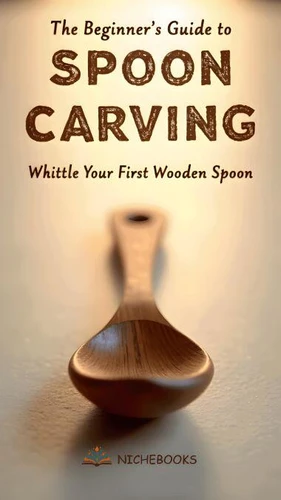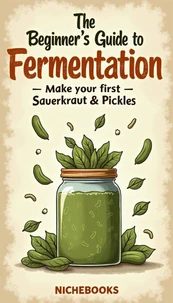Nouveauté
The Beginner's Guide to Spoon Carving: Whittle Your First Wooden Spoon
Par :Formats :
Disponible dans votre compte client Decitre ou Furet du Nord dès validation de votre commande. Le format ePub est :
- Compatible avec une lecture sur My Vivlio (smartphone, tablette, ordinateur)
- Compatible avec une lecture sur liseuses Vivlio
- Pour les liseuses autres que Vivlio, vous devez utiliser le logiciel Adobe Digital Edition. Non compatible avec la lecture sur les liseuses Kindle, Remarkable et Sony
 , qui est-ce ?
, qui est-ce ?Notre partenaire de plateforme de lecture numérique où vous retrouverez l'ensemble de vos ebooks gratuitement
Pour en savoir plus sur nos ebooks, consultez notre aide en ligne ici
- FormatePub
- ISBN8232877415
- EAN9798232877415
- Date de parution02/09/2025
- Protection num.pas de protection
- Infos supplémentairesepub
- ÉditeurHamza elmir
Résumé
"The Beginner's Guide to Spoon Carving: Whittle Your First Wooden Spoon" offers a comprehensive, step-by-step journey into the rewarding craft of wood carving, specifically designed for novices. This guide highlights why a spoon is the perfect first project, being both simple and complete, teaching core skills while delivering a tangible, functional result. Its low tool and space requirements make it an accessible entry point into green woodworking, fostering quick wins and sustained motivation.
Readers will gain a strong foundation in wood selection and preparation, learning to identify the best woods for beginners like basswood, birch, and cherry. The guide details the advantages of green wood versus seasoned wood, teaching how to read grain direction and orient the blank to ensure strength and prevent tear-out. Practical advice on choosing, inspecting, and preparing blanks is also included.
The publication focuses on essential tools and maintenance, introducing the three tools you need: a straight carving knife for shaping, a hook knife (or crook knife) for hollowing the bowl, and a small axe or saw for blank preparation. Emphasis is placed on sharpening basics and tool care to ensure tools work well and hands stay safe, along with establishing an effective workstation. Fundamental carving techniques are taught through detailed instruction on core cuts: push cuts for bulk removal, pull cuts for refining edges, and stop cuts to control transitions.
Safe grips, hand positions, and preventing common mistakes are integrated throughout, stressing control and safety during all stages, including hollowing techniques with the hook knife. The book culminates in a step-by-step spoon project, guiding the carver from blank selection through initial oiling. Finally, it covers finishing and long-term care, including sanding techniques, choosing food-safe finishes (such as walnut oil, flaxseed, or beeswax/mineral oil blends), and essential spoon care and maintenance to ensure durability and beauty for years of use.
This guide equips beginners with a reliable process to repeat, allowing them to improve consistently and create spoons they'll be proud to use every day
Readers will gain a strong foundation in wood selection and preparation, learning to identify the best woods for beginners like basswood, birch, and cherry. The guide details the advantages of green wood versus seasoned wood, teaching how to read grain direction and orient the blank to ensure strength and prevent tear-out. Practical advice on choosing, inspecting, and preparing blanks is also included.
The publication focuses on essential tools and maintenance, introducing the three tools you need: a straight carving knife for shaping, a hook knife (or crook knife) for hollowing the bowl, and a small axe or saw for blank preparation. Emphasis is placed on sharpening basics and tool care to ensure tools work well and hands stay safe, along with establishing an effective workstation. Fundamental carving techniques are taught through detailed instruction on core cuts: push cuts for bulk removal, pull cuts for refining edges, and stop cuts to control transitions.
Safe grips, hand positions, and preventing common mistakes are integrated throughout, stressing control and safety during all stages, including hollowing techniques with the hook knife. The book culminates in a step-by-step spoon project, guiding the carver from blank selection through initial oiling. Finally, it covers finishing and long-term care, including sanding techniques, choosing food-safe finishes (such as walnut oil, flaxseed, or beeswax/mineral oil blends), and essential spoon care and maintenance to ensure durability and beauty for years of use.
This guide equips beginners with a reliable process to repeat, allowing them to improve consistently and create spoons they'll be proud to use every day
"The Beginner's Guide to Spoon Carving: Whittle Your First Wooden Spoon" offers a comprehensive, step-by-step journey into the rewarding craft of wood carving, specifically designed for novices. This guide highlights why a spoon is the perfect first project, being both simple and complete, teaching core skills while delivering a tangible, functional result. Its low tool and space requirements make it an accessible entry point into green woodworking, fostering quick wins and sustained motivation.
Readers will gain a strong foundation in wood selection and preparation, learning to identify the best woods for beginners like basswood, birch, and cherry. The guide details the advantages of green wood versus seasoned wood, teaching how to read grain direction and orient the blank to ensure strength and prevent tear-out. Practical advice on choosing, inspecting, and preparing blanks is also included.
The publication focuses on essential tools and maintenance, introducing the three tools you need: a straight carving knife for shaping, a hook knife (or crook knife) for hollowing the bowl, and a small axe or saw for blank preparation. Emphasis is placed on sharpening basics and tool care to ensure tools work well and hands stay safe, along with establishing an effective workstation. Fundamental carving techniques are taught through detailed instruction on core cuts: push cuts for bulk removal, pull cuts for refining edges, and stop cuts to control transitions.
Safe grips, hand positions, and preventing common mistakes are integrated throughout, stressing control and safety during all stages, including hollowing techniques with the hook knife. The book culminates in a step-by-step spoon project, guiding the carver from blank selection through initial oiling. Finally, it covers finishing and long-term care, including sanding techniques, choosing food-safe finishes (such as walnut oil, flaxseed, or beeswax/mineral oil blends), and essential spoon care and maintenance to ensure durability and beauty for years of use.
This guide equips beginners with a reliable process to repeat, allowing them to improve consistently and create spoons they'll be proud to use every day
Readers will gain a strong foundation in wood selection and preparation, learning to identify the best woods for beginners like basswood, birch, and cherry. The guide details the advantages of green wood versus seasoned wood, teaching how to read grain direction and orient the blank to ensure strength and prevent tear-out. Practical advice on choosing, inspecting, and preparing blanks is also included.
The publication focuses on essential tools and maintenance, introducing the three tools you need: a straight carving knife for shaping, a hook knife (or crook knife) for hollowing the bowl, and a small axe or saw for blank preparation. Emphasis is placed on sharpening basics and tool care to ensure tools work well and hands stay safe, along with establishing an effective workstation. Fundamental carving techniques are taught through detailed instruction on core cuts: push cuts for bulk removal, pull cuts for refining edges, and stop cuts to control transitions.
Safe grips, hand positions, and preventing common mistakes are integrated throughout, stressing control and safety during all stages, including hollowing techniques with the hook knife. The book culminates in a step-by-step spoon project, guiding the carver from blank selection through initial oiling. Finally, it covers finishing and long-term care, including sanding techniques, choosing food-safe finishes (such as walnut oil, flaxseed, or beeswax/mineral oil blends), and essential spoon care and maintenance to ensure durability and beauty for years of use.
This guide equips beginners with a reliable process to repeat, allowing them to improve consistently and create spoons they'll be proud to use every day




